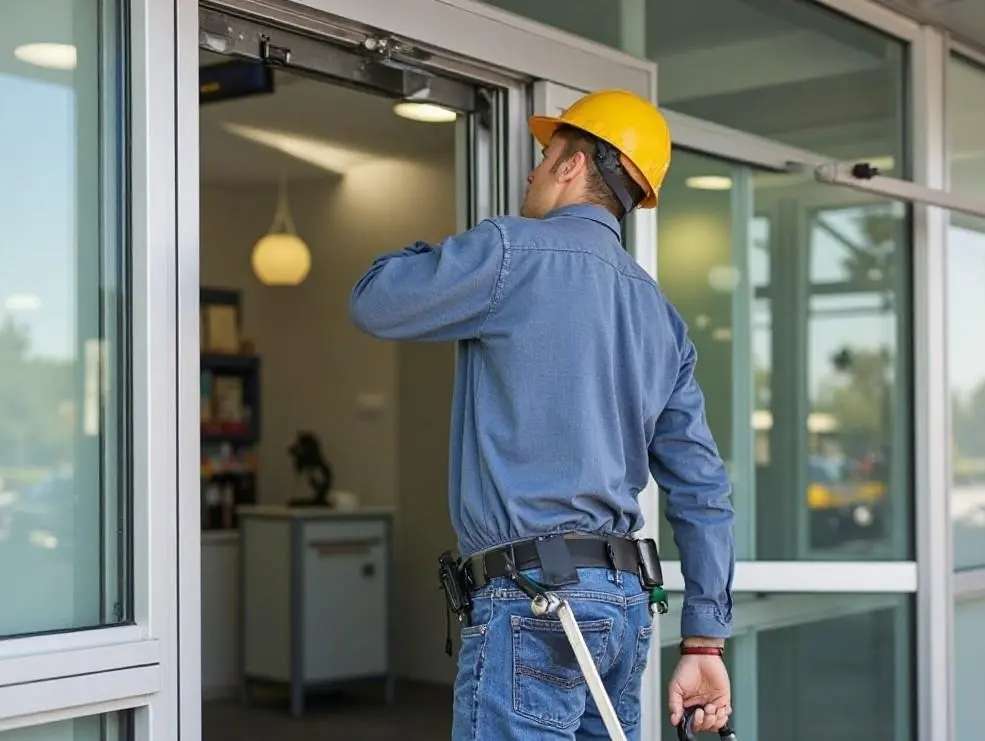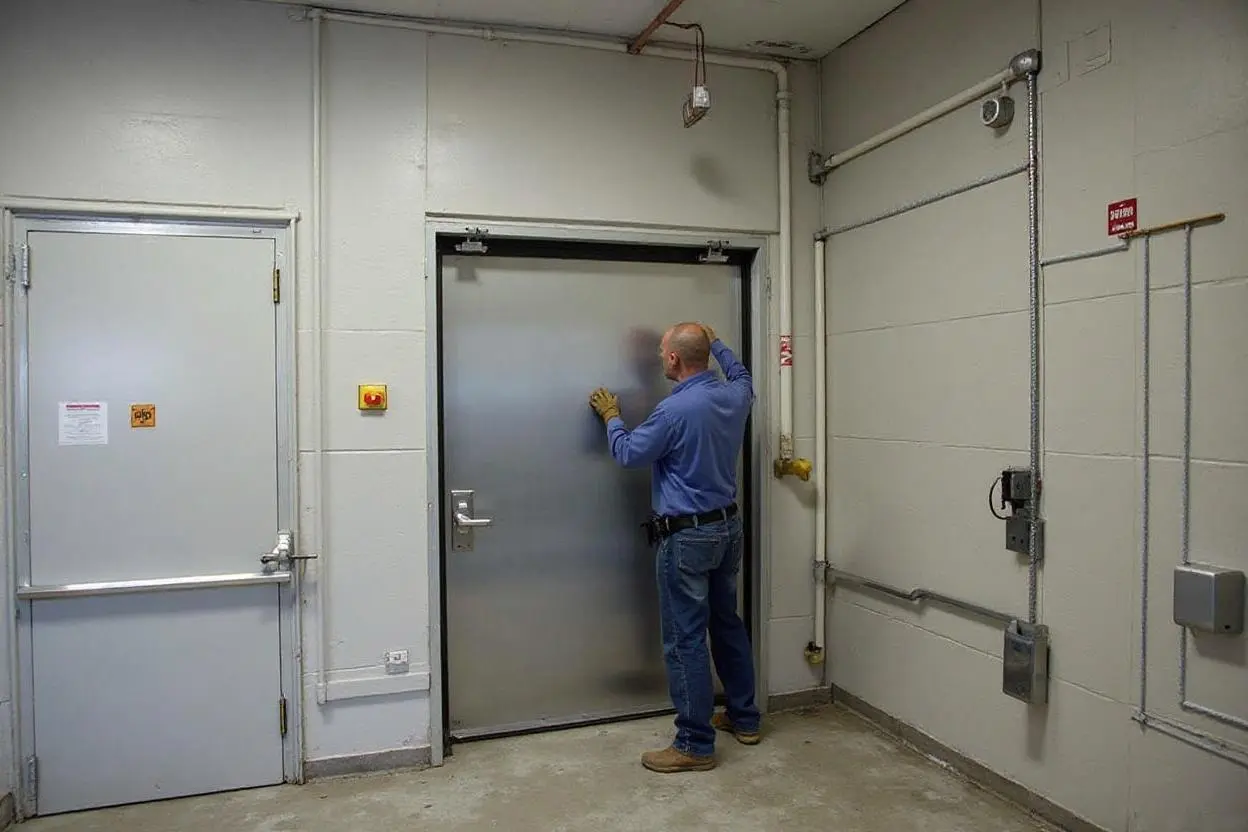Do Sliding Doors Need Maintenance?
Sliding doors look simple. A pane of glass glides along a track, and the room gains light and space. In practice, that door is a system of rollers, guides, weather seals, sensors, and safety devices that all work together. Without basic care, small issues turn into hard pulls, scraping noises, sliding door drafts, or a door that refuses to move on a snowy Buffalo morning.
This guide explains what maintenance sliding doors need, what a homeowner can handle, and when it is time to call A-24 Hour Door National Inc. for professional service in Buffalo, NY. It covers both manual patio sliders and automatic sliding doors found in storefronts, multifamily buildings, and medical offices. The principles overlap, but safety standards and components differ.
Why maintenance matters in Buffalo’s climate
Buffalo winters drive grit and rock salt into tracks. Spring brings thaw cycles that swell wood framing and shift alignments. Summer humidity swells gaskets. These seasonal swings speed up wear on rollers, tracks, and seals. Doors that go unserviced drag and rattle, chew through hardware, and leak conditioned air. For commercial properties, neglected automatic sliding doors can also fail state and ANSI safety checks, exposing owners to liability.
A few minutes of routine care reduces energy loss, keeps movement smooth, and protects the glass and hardware. For automatic door maintenance, a structured service plan keeps sensors responsive, door speeds within spec, and safety features in working order.
What a homeowner can do on a manual sliding door
Most patio sliders respond well to simple, periodic care. The frequency depends on traffic and exposure. An exterior slider that faces a driveway usually needs more attention than a protected courtyard door.
- Clean the track: Vacuum the lower track, then wipe it with a damp cloth. Avoid heavy lubricants here; they attract grit. For stubborn buildup, a nylon brush works well. Do this monthly in winter and spring.
- Lubricate the rollers and lock: Use a silicone spray on the roller axles and latch mechanism. Aim for a light coat. Wipe excess. Do this every 3 to 6 months.
- Check and adjust roller height: If the door drags or scrapes, use the small access holes at the bottom rail to raise or lower rollers. Turn the screw a quarter-turn at a time until the gap is even and the door moves freely.
- Inspect weatherstripping: Look for flattened or torn pile. Replace sections that no longer seal. Fresh weatherstripping makes a big difference in draft control along Lake Erie’s shoreline.
- Wash and check the glass: Clean both sides and look for edge chips or cracked corners near the rollers. Chips spread under vibration, especially during freeze-thaw cycles.
These steps solve most sticking and draft complaints. If the door still feels heavy or jumps in the track, the rollers may be pitted or oval and need replacement. That is a quick fix for a tech with the right parts.
How automatic sliding doors differ
Automatic sliding doors introduce sensors, controllers, motor gearboxes, belts, and safety devices that must work in sync. They are covered by ANSI/BHMA A156.10 or A156.38 standards and require documented inspections. Common in Buffalo storefronts, clinics, and apartment lobbies, these doors carry higher traffic and have less tolerance for misalignment.
A typical automatic sliding door assembly includes:
- Presence and motion sensors that detect approach and hold-open needs.
- Safety beams across the threshold to prevent closing on people or carts.
- A header with controller, motor, belt or chain, hangers, and track.
- Bottom guides and floor tracks that keep the leaf plumb.
- Battery backup or breakout features for egress.
Because safety depends on correct speed, force, and timing, automatic door maintenance should be handled by trained technicians with test tools and access to OEM parts.
Signs your sliding door needs service
A door usually warns before it fails. Homeowners and facility managers in Buffalo should watch for these clues:
- Manual slider: grinding sound, flat spots felt through the handle, daylight at the jamb, latch that needs extra force, ice buildup inside the track, or a screen that no longer tracks parallel.
- Automatic slider: slow start, sudden stop, door that reopens after attempting to close, excessive closing force, sensor false triggers in lake-effect snow, or ADA push-plate that fails intermittently.
If any safety feature on an automatic door seems inconsistent, take the door out of service and call for professional repair. Temporary cones and a “Use Other Door” sign help keep traffic safe until a technician arrives.
What professional automatic door maintenance includes
A-24 Hour Door National Inc. follows a structured process for automatic doors that balances reliability, safety, and code requirements. A typical maintenance visit in Buffalo, NY includes:
- Functional testing: Verify activation zones, presence detection, and safety beams with calibrated test objects. Confirm open and close speeds meet manufacturer specs and ANSI standards.
- Mechanical inspection: Check hanger bolts, track wear, guide shoes, belt tension, gearbox noise, and breakout function. Tighten hardware to torque specs.
- Electrical checks: Inspect wiring harnesses for abrasion from winter grit, confirm grounding, test power supply and backup battery health where applicable.
- Cleaning and lubrication: Remove packed salt and debris from floor tracks and guides. Apply manufacturer-approved lubricants only where specified.
- Documentation: Provide a written report with measurements, adjustments made, and any parts recommended. For property managers, consistent records help during insurance or safety audits.
Most facilities schedule quarterly or semiannual service, with monthly visual checks by staff. High-traffic entries, grocery stores, and medical facilities benefit from quarterly service due to volume and weather exposure.
Energy and comfort payoffs
Drafty sliders are common along windy corridors off Lake Erie. Replacing worn bottom sweeps and interlocks often trims noticeable heat loss. In older homes, a well-adjusted slider can cut air leakage by a surprising margin. On commercial entries, correct close speeds and seal compression reduce stack effect and keep vestibules comfortable. These gains add up over Buffalo’s long heating season.
Cost ranges and parts that usually fail
Parts pricing varies by brand, but patterns are consistent:
- Manual sliders: Nylon or steel rollers often fail first. Replacements typically range from low to mid hundreds including labor, depending on access and brand. New weatherstripping is inexpensive and can be done during the same visit.
- Automatic sliders: Sensor replacements and belts are common. Sensors generally range from mid to high hundreds each, while a belt and tune falls in a similar band. Controllers and gear motors cost more and are usually a planned replacement once diagnostics confirm wear.
Correct diagnosis saves money. For example, a “hesitation” complaint might be a dirty presence sensor, not a failing motor. A quick cleaning and recalibration avoids an unnecessary parts swap.
Safety notes property owners should know
Automatic doors must react safely to adults, children, pets, wheelchairs, and carts. Standards limit closing force and set minimum hold-open times. After a snowstorm, drifting snow can block sensors and cause erratic behavior. Staff should clear the sensor areas and tracks during snow removal. Never tape over a sensor to stop false triggers; that disables a primary safety system.
For manual patio doors, tempered glass is standard. If a crack appears, avoid slamming or heavy operation. Schedule replacement promptly to prevent a shatter event during a cold snap.
DIY limits and smart handoffs
Homeowners handle cleaning, light lubrication, and roller height adjustments well. They can even replace weatherstripping with basic tools. Roller replacement is doable for handy owners, but large panels are heavy and awkward; a two-person lift and proper support are essential to avoid frame twist.
On automatic doors, owners should clean floor tracks and gently wipe sensor lenses, but leave speed, force, and sensor alignment to a professional. The cost of a service call is small compared to an injury claim or an extended outage at a main entrance.

Local quirks A-24 Hour Door National Inc. sees in Buffalo
Experience in Buffalo brings repeating patterns:
- Salt and cinders in winter grind rollers and chew aluminum tracks faster than in milder regions. Shorter maintenance intervals pay off from December through March.
- Lake-effect moisture fogs sensor lenses and lowers infrared sensitivity. Routine cleaning during storms restores normal detection.
- Freeze-thaw movement in masonry openings shifts header alignment. A seasonal check catches this before it wears hangers and belts.
- Patio sliders facing south bake gaskets in summer sun, then stiffen in winter. A quick gasket refresh restores smooth latching and better sealing.
Technicians who live with these conditions set the door up to handle them — slightly different lubricant choices, tighter weatherstrip fit, and sensor tuning that resists snow swirl false trips.
How often to maintain sliding doors
Practical intervals by use and type:
- Manual residential: clean tracks monthly in winter, lubricate and inspect every 3 to 6 months, full roller and latch check annually.
- Light-use automatic (small office, condo lobby): professional service every 6 months, with monthly visual checks by staff.
- High-use automatic (retail, healthcare): professional service every 3 months, plus weekly quick checks by staff for debris and sensor cleanliness.
If a door serves as an accessible entrance, do not stretch intervals. Accessibility depends on reliable, predictable function.
Ready for smoother doors in Buffalo?
A sticking patio slider or a quirky automatic entrance slows down daily life. A-24 Hour Door National Inc. services sliding doors across Buffalo, Amherst, Cheektowaga, Tonawanda, West Seneca, and nearby towns. The team handles routine tune-ups, automatic door maintenance to ANSI standards, emergency repairs, and part replacements for most brands.

For fast scheduling, describe the symptoms, door brand if visible, and a quick photo of the track or header label. That helps the technician arrive with the right rollers, sensors, or belts. Call today to get a smooth, quiet glide back — before the next lake-effect storm rolls through.
A-24 Hour Door National Inc provides commercial and residential door repair in Buffalo, NY. Our technicians service and replace a wide range of entry systems, including automatic business doors, hollow metal frames, storefront entrances, fire-rated steel and wood doors, and both sectional and rolling steel garage doors. We’re available 24/7, including holidays, to deliver emergency repairs and keep your property secure. Our service trucks arrive fully stocked with hardware, tools, and replacement parts to minimize downtime and restore safe, reliable access. Whether you need a new door installed or fast repair to get your business back up and running, our team is ready to help. A-24 Hour Door National Inc
344 Sycamore St Phone: (716) 894-2000 Website: https://a24hour.biz/buffalo
Instagram: @a24hourdoor
Buffalo,
NY
14204,
USA
Facebook: 24 Hour Door
Yelp: A-24 Hour Door National (Buffalo)
X (Twitter): @a24hrdoor